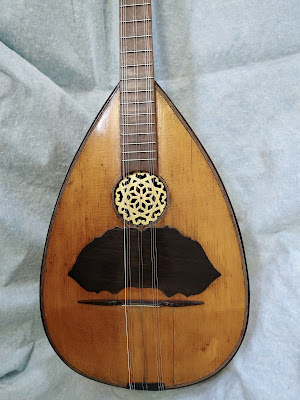The war hero and the “Uknown “ luthier
And a label with few historical information !
From time to time, there are these stories, regarding people’ lives, which can really captivate us!
Twelve years in the “making” of this blog , I have come across few stories of individuals, which inspired me and deeply captivated me. The following is one of them !
It was a cold night of February when I contacted Cheri, a lady who buys estate antique furnitures , restores them, and re-sales them. She had in her possession an old violin and an old lute/ mandolin with a long neck.
The deceased owner of the instruments accordingly to Cheri was a gentleman who served during the World War 2 and lived a long period of his life in Boston USA and in Germany.
He was a very refined man and had a taste for very fine things in life. Cheri had acquired a lot of things that belong to him. Sadly they were just disregarded and nobody cared about them. She had felt the need to hold onto them, and learn more about him.
The long-neck lute accordingly to Cheri, had a maker’s label but the wooden rosette , prevented her from seeing and identifying the language on which the label was written, and what was also written. Due to the blurry photos of the instrument (which Cheri had originally sent me ) became unclear if this was a Greek musical instrument, or a string instrument from the surrounded Balkan region . The pick-guard of the instrument had gone under an amateur restoration with additional material added on each side of the sound hole, fact that made it very odd to be an old Greek bouzouki at the first sight.
But both Cheri and I were determined to solve the riddle regarding this string musical instrument’s origin
After many unsuccessful tries by Cheri in an attempt to captivate with her camera the inside of the label, she decided to write on a piece of paper the letters of the label which she could easily see and identify with naked eye.
Two days later, Mr Panagotopulos bouzouki was delivered at the talented hands of the luthier Chris Pantazelos who for once again performed an absolutely superb restoration !
At this point I would like to also express my “thank you” to the talented luthier and researcher Petros Moustakas who gave me valuable information regarding the missing tailpiece wooden hitch-pins.
-Bowl : 9 Mahogany and 10 Cypress wood. It has back capping strip but absence of side strips
-Soundboard : Red spruce wood
-Neck : brown stained Pine wood
-Headstock : brown stained Pine wood
-Neck to headstock V joint
-Bridge : brown stained maple or plane wood
-Fretboard : Angelique wood (?) or other tropical hardwood
-Rosette : Cretan maple, painted gold
-Pick-guard : walnut veneer, dyed black
-Frets: bar frets ( Nickel- silver )
-Tuning machines : brass with silver plated, old style with the gear furthest away from fingerboard.
-Tuner knobs : made out of bone
-Fret markers : natural mother of pearl
-Side dots : metal -possible nails (original)
-Binding : black walnut veneer and holy veneer
-Instead of tailpiece : three wooden pins
-Construction of soundboard : Considerable arch approx 8-9 mm
-Finish : mat - few layers of French polishing / shellac
-Glue used for the construction : milk casein glue
-Scale: 64.2 cm
-Overall length : 91 cm
-Length of bowl : 35.6 cm
-Width of bowl: 24.2 cm
-String set up : 3-2-3
-Circa: approx 1905-1910























Comments
Post a Comment